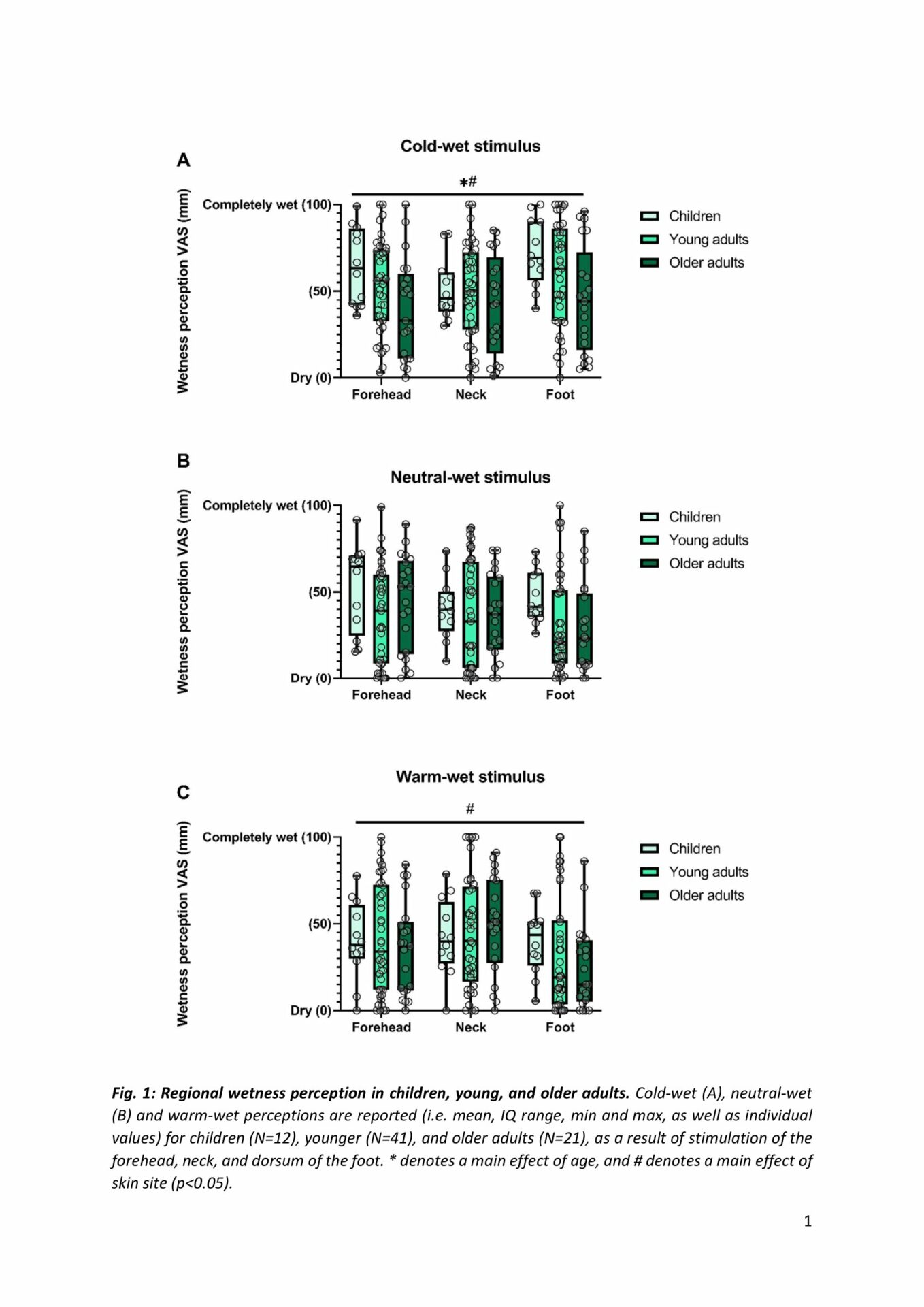Introduction
Perceiving the skin wetness that our body produces (e.g. by sweating) or contacts (e.g. when damp clothing touches our skin), i.e. hygrosensing, is an essential sensory function that supports behavioural thermoregulation [1]. We have previously demonstrated that, in the absence of skin hygroreceptors, young adults perceive skin wetness by integrating multisensory thermal (e.g. cold) and tactile (e.g. stickiness) inputs from skin contact with moisture [2]. Yet, the development and decline of hygrosensation through life remains unclear. This study aimed to investigate differences in wetness sensitivity across the body amongst a large cohort of children, young, and older adults.
Methods
Seventy four participants, including 12 children (4F/8M, mean age: 12±3y; range: 7-15y), 41 younger (21F/20M, mean age: 25±4y; range: 20-34y) and 21 older adults (11F/10M, mean age: 55±6y; range: 45-65y), underwent quantitative sensory testing during which they reported perceived magnitudes (i.e. 100mm Visual Analog Scale from dry to completely wet) of local wetness perceptions arising from the short-duration (i.e. 10s) static application (counter-balanced order) of a cold-wet (i.e. 5°C below local skin temperature), neutral-wet (i.e. equal temperature as local skin temperature), and warm-wet (i.e. 5°C above local skin temperature) handheld temperature-controllable probe (surface: 1.32cm2; water content: 0.8ml) to the centre of the forehead, neck area, and foot dorsum. Perceptual scores from cold-, neutral-, and warm-wet stimulations were analysed for the independent and interactive effects of age (i.e. children vs. younger vs. older adults) and skin site (forehead vs. neck vs. foot) using a 2-way mixed model ANOVA. All methods accorded with ethical legislation.
Results
We found a statistically significant main effect of age on cold-wetness sensing (p=0.031). Post-hoc analyses indicated that, irrespective of body region, children were more sensitive than older adults (mean difference: 20.4mm [95%CI: 1.3, 39.5], corresponding to 20% difference; p=0.033; Fig. 1A), and as sensitive as younger adults (mean difference: 8.5mm [95%CI: -8.7, 25.8], p=0.467). We also found a main effect of skin site on cold-wetness sensing (p=0.014). Post-hoc analyses indicated that, irrespective of age, the foot was more sensitive than the neck (mean difference: 11.1mm [95%CI: 2.2, 20.0], corresponding to 11% difference; p=0.011; Fig. 1A). We found no main effect of age on warm (p=0.842, Fig. 1B) or neutral wetness perception (p=0.158, Fig. 1C), yet we found a main effect of skin site on warm wetness sensing, with the foot being less sensitive than the neck (mean difference: 12.9mm [95%CI: 2.8, 23.0], corresponding to 13% difference; p=0.008; Fig. 1A).
Conclusions
We provide novel evidence that children as young as 12 years old present a level of wetness sensitivity that matches young adults in both magnitude and regional patterns (i.e. distal vs. proximal differences between neck and foot). Ageing appears to decrease cold-wetness sensitivity only, which may be underlined by differences in age-induced degeneration of cold-sensing myelinated (AΔ fibers) vs. warm-sensing unmyelinated (C-fibers) thermoreceptors innervating the skin and contributing to wetness sensing [3]. This knowledge may be applied to inform the design of sport garments with sweat management properties matching the wetness sensitivity of different age groups.

